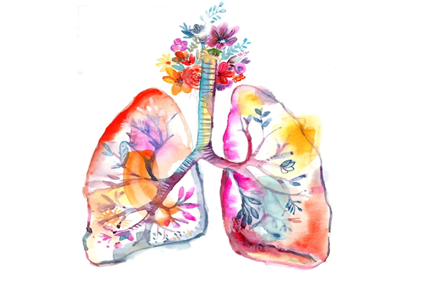More people die from lung cancer than any other type of cancer. At Johns Hopkins, our goal is to reduce that number every year, working toward a day when no one will die from lung cancer.
At the Lung Cancer Program, we focus on preventing, screening for, diagnosing and treating lung cancer in ways that give our patients the best possible prognosis.
-
Our Team
Meet our lung cancer experts.
-
Multidisciplinary Clinics
Learn more about our specialty areas.
Appointment Locations
The Johns Hopkins Kimmel Cancer Center has locations in Baltimore and Washington, D.C.
Washington, D.C. Area Locations
Battling Lung Cancer with Immunotherapy
Watch John Ryan and his doctor Julie Brahmer, M.D. discuss the hope of immunotherapy for people with squamous-non-small cell lung cancer.
Lung Cancer Support Group
2nd Thursday every month 5:30-7:00 pm
- January 11: Thoracic Surgery
- February 8: Spiritual Care
- March 14: Pharmacy Updates
- April 11: Exercise and Relaxation
- May 9: Advance Practice Providers
- June 13: Pulmonary Rehab
For more information & RSVP Tony Forte, LMSW
410-550-6565
Join Zoom Meeting: https://jhjhm.zoom.us/j/97563887847?pwd=TjAyWjJTUmluSHhHTDYwR3NmYkQyQT09

The following list is provided by the Living with Cancer Resource Program of the Sidney Kimmel Comprehensive Cancer Center. Please call (410) 614-1308 for more information about this program and upcoming events.
-
1-888-227-6333
http://www.cancer.org/This is the Resource Center of the American Cancer Society for Delaware, D.C., Maryland, Virginia and West Virginia.
Programs include:
- "Road to Recovery" provides transportation assistance for medically needy patients to and from treatment
- Medication program provides limited financial assistance for pain and nausea medications
- Hope Lodge is a "home away from home,” located in Baltimore City, for patients and families needing local accommodation during the course of cancer treatment
- Look Good & Feel Better" is a program designed to help women cope with the appearance-related side effects of cancer treatment (offered at the Harry and Jeanette Weinberg Building and Green Spring Station throughout the year. Contact: Cheryl Fleming at: 410-955-6549 for details)
-
1-800-686-4872
https://www.lung.org/This national, nonprofit organization is dedicated to conquering lung disease and promoting lung health. Services include: Cancer information
-
1-800-813-4673
http://www.cancercare.org/This national organization offers a variety programs to patients and their families. A very informative publication, available online, is A Helping Hand the Resource Guide for People with Cancer, which highlights national and regional programs and organizations serving those with cancer.
Services include:
- Web site with resource and cancer information
- Support groups (including those linked by telephone and web) for those diagnosed with specific types of cancer
- Educational programs and workshops
- Teleconferences with educational presentations by health care professionals for patients and families
-
1-800-298-2436
http://www.lungcanceralliance.org/The Lung Cancer Alliance is a national, nonprofit organization providing advocacy and support exclusive to lung cancer patients, survivors, families, caregivers, and those at risk for the disease.
Support programs include:
- Lung Cancer Hotline
- Toll-free information and referral service
- Phone Buddies Program, a peer-to-peer support network
- Online support community
- Clinical trials matching service
- Newsletter
- Specialized lung cancer information and educational materials
-
312-464-0716
http://www.lungevity.org/LUNGevity Foundation is the largest private funder of lung cancer research with a world-renowned scientific board, the largest lung cancer grassroots network and the largest online lung cancer support network offering 24 hour peer-to-peer support, Ask the Experts, buddy program and advocacy program. The mission of LUNGevity Foundation is to have a meaningful and immediate impact on improving lung cancer survival rates, ensure a higher quality of life for lung cancer patients, and provide a community for those impacted by lung cancer.
Support programs Include:
- Ask the Experts
- One-on-one support
- Online lung cancer caregiver center
- Annual national HOPE Summit
- Provide the opportunity and platform to raise awareness and help make lung cancer a national priority with the LUNGevity Link Up advocacy training program
-
Provides free publications about a variety of topics related to cancer, its treatment, and managing side effects. Recommended publications include:
- What You Need to Know About Lung Cancer
- Taking Time: Support for People with Cancer and the People Who Care About Them
- Facing Forward: A Guide for Cancer Survivors
- Smoking Facts and Tips for Quitting
- Questions and Answers about Pain Control: A Guide for People with Cancer and Their Families
- Eating Hints for Cancer Patients
- Advanced Cancer: Living Each Day
-
Provides a variety of free programs to patients and their families living with cancer, including support groups and educational sessions. There are Wellness Community locations include: Towson, MD; Paoli, PA; Philadelphia, PA; New Town, PA; Perrysburg, OH; Knoxville, TN; Oak Ridge, TN: Phoenix, AZ; San Diego, CA; and Las Vegas, NV.
-
Look Good Feel Better is dedicated to improving the self-esteem and quality of life of people undergoing treatment for cancer. It is our aim to improve their self-image and appearance through complimentary group, individual, and self-help beauty sessions that create a sense of support, confidence, courage and community.
About Lung Cancer
Learn more about lung cancer in our Health section:







